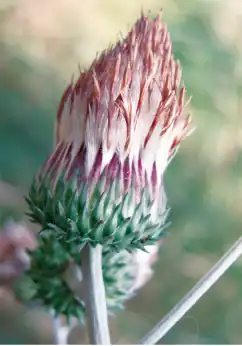Ptilostemon greuteri
| Ptilostemon greuteri | |
|---|---|

| |
| Scientific classification | |
| Kingdom: | Plantae |
| Clade: | Tracheophytes |
| Clade: | Angiosperms |
| Clade: | Eudicots |
| Clade: | Asterids |
| Order: | Asterales |
| Family: | Asteraceae |
| Tribe: | Cardueae |
| Subtribe: | Carduinae |
| Genus: | Ptilostemon |
| Species: | P. greuteri
|
| Binomial name | |
| Ptilostemon greuteri Raimondo & Domina
| |
Ptilostemon greuteri is a species of flowering plant in the family Asteraceae.[2] It is a shrub endemic to western Sicily.[1]
Ptilostemon greuteri is a woody thistle which generally grows from 0.5 to 2 meters tall, and occasionally to 3.5 meters tall. It is the largest species and has the largest leaves in the genus.[3] It is endemic to Monte Inici near Castellammare del Golfo in Trapani Province of northwestern Sicily. It was known from a single population in Cappellone Valley, where it grows in shrubland on rocky slopes, on cliffs, and at cliff bases from 200 to 500 metres elevation.[1] A second population was discovered in 2022, growing in similar conditions.[3] The species' area of occupancy (AOO) is less than 4 km2 and it has an estimated population of about 250 plants. The species is threatened with a continuing decline in the extent and quality of its habitat, from fires and from abandonment traditional grazing practices which has allowed the shrub canopy to close. It is assessed as critically endangered by the IUCN.[1]
References
- ^ a b c d Rivers, M.C. 2017. Ptilostemon greuteri. The IUCN Red List of Threatened Species 2017: e.T103454421A103454429. https://dx.doi.org/10.2305/IUCN.UK.2017-3.RLTS.T103454421A103454429.en. Accessed 4 August 2025.
- ^ "Ptilostemon greuteri Raimondo & Domina". Plants of the World Online. Royal Botanic Gardens, Kew. Retrieved 4 August 2025.
- ^ a b Salvatore Pasta, Alessandro Silvestre Gristina, Leonardo Scuderi, Laurence Fazan, Corrado Marcenò, Riccardo Guarino, Viviane Perraudin, Gregor Kozlowski, Giuseppe Garfì, Conservation of Ptilostemon greuteri (Asteraceae), an endemic climate relict from Sicily (Italy): State of knowledge after the discovery of a second population, Global Ecology and Conservation, Volume 40, 2022, e02328, ISSN 2351-9894, https://doi.org/10.1016/j.gecco.2022.e02328.
